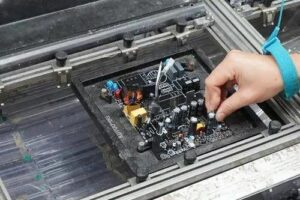In the installation process of electronic components, whether it is manual installation or automated equipment installation, a series of operating norms and precautions must be strictly followed to ensure the quality and reliability of electronic products.
The following are several aspects that need special attention when installing electronic components:
1、 Anti static measures
Electronic components are extremely sensitive to static electricity, therefore strict anti-static measures must be taken during installation. Operators should wear anti-static clothing and anti-static wristbands to ensure a moderate humidity in the working environment and reduce the generation of static electricity. At the same time, anti-static pads should be laid on the workbench, and all tools and equipment should also be grounded to prevent static electricity from causing damage to components.
2、 Identification and inspection of components
Before installation, it is necessary to carefully identify and inspect the components. Confirm that the model and specifications of the components match the design requirements, inspect whether the appearance is intact and undamaged, and whether the pins are straight and free of oxidation. For components with special requirements, such as capacitors that require aging or transistors that require preheating, pre-treatment should also be carried out according to the corresponding process requirements.
3、 Correct installation method and sequence
The installation of components should follow the principles of small before large, light before heavy, low before high, tantalum capacitors and resistors before other components. For sensitive components such as integrated circuits, specialized installation tools should be used to avoid direct contact with pins by hand. During the installation process, ensure that the pins of the components are aligned with the solder pads on the printed circuit board to avoid virtual soldering or short circuits.
4、 Welding process control
Welding is a crucial step in the installation process of electronic components. Suitable solder and flux should be selected, and welding temperature and time should be strictly controlled to avoid damaging components or causing poor welding due to overheating. For products with higher requirements, automated welding equipment can be used to improve welding quality and efficiency.
5、 Inspection and testing after installation
After installation, the circuit board must be carefully inspected and tested. The inspection content includes whether the components are securely installed, whether the pins are soldered well, and whether there are any short circuits or virtual soldering phenomena. Testing includes functional testing, performance testing, and aging testing to ensure that product quality meets design requirements.
6、 Safety protection and cleaning
During the installation process, operators must wear appropriate protective equipment, such as anti-static wristbands, goggles, etc., to ensure personal safety. At the same time, the working environment should be kept clean and tidy to avoid quality hazards caused by dust or debris. After installation, the product should also be cleaned to remove possible pollutants and impurities.
The installation of electronic components is a complex and meticulous process that requires operators to have rich experience and a rigorous work attitude. By strictly adhering to the above precautions and operating procedures, the quality and reliability of electronic products can be greatly improved, providing high-quality products and services for the procurement of electronic equipment manufacturers.
















